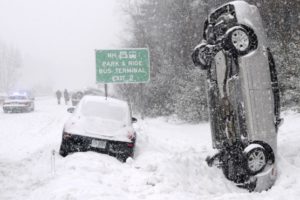Five Tips for Safe Winter Driving
It’s that of the year again when you have to be extra cautious on the roads whether you’re driving a car, riding a bike or even walking. Winters bring the opportunity to play winter sports, wear trendy yet warm clothes and sip on hot drinks. But for commuters, it also comes with slippery roads, reduced visibility, and lots and lots of traffic jams, not to mention a higher risk of accidents. What can you do to minimize your risk of an accident as a driver as well as a pedestrian? Your friends at urSTORE have five tips for a safer winter commute:
1. Make your car/bike more visible by turning the lights on.
Winter days are shorter so when you leave for work, it may still be dark. It’s of utmost importance to turn all your lights on in your vehicle. Keep spare bulbs in your car in case you need a replacement because you wouldn’t want to drive to the automotive store with a failed brake or indicator light. If you’re a pedestrian, make sure you wear reflective clothing so drivers can spot you easily.
2. Carry a safety kit with you.
Besides signing up for roadside assistance (don’t cheap out on this expense), it’s essential to carry a basic survival kit that includes tools like scraper, shovel, washer fluid, spare tire as well as warm jacket, gloves, water and canned food in case you get stranded.
3. Get winter tires.
This might as well be your first priority considering the fact that years of research has shown how drastic a difference it makes to have winter tires on your car compared to regular all-season tires. Some of the benefits of winter tires is reduced braking time and lower risk of skidding. It’s equally important to monitor the pressure in the tires because as the weather becomes cooler, so should the air pressure in your tires.
4. Prevent your vehicle from skidding.
The only safe way to brake on icy and slippery roads is to brake slightly and as your car’s speed lowers, pressing the brake pedal further to come to a full stop. If you push your brake all the way down all at once, you run the risk of your vehicle slipping and sliding. This brings us to another key point which is avoid the urge to tailgate the car ahead of you. If you have no distance from the car in front of you and that car stops for whatever reason, you’ll rear-end the car because you didn’t leave enough space to allow your car to come to a full stop.
5. Don’t stop in the middle of the road.
If you see someone stranded on the road, don’t stop to help even it feels like the right thing to do. On icy roads, other drivers may find it difficult to avoid crashing into your parked car. The best thing you can do is call the authorities because they have the ability to divert the traffic flow and manage the situation in a safe manner. Stopping to help a stranded car/person can cause more harm than good.
Please support our social media efforts by following us on Facebook and Twitter.


